150th Anniversary of Establishment of Serbian Technicians’ Society


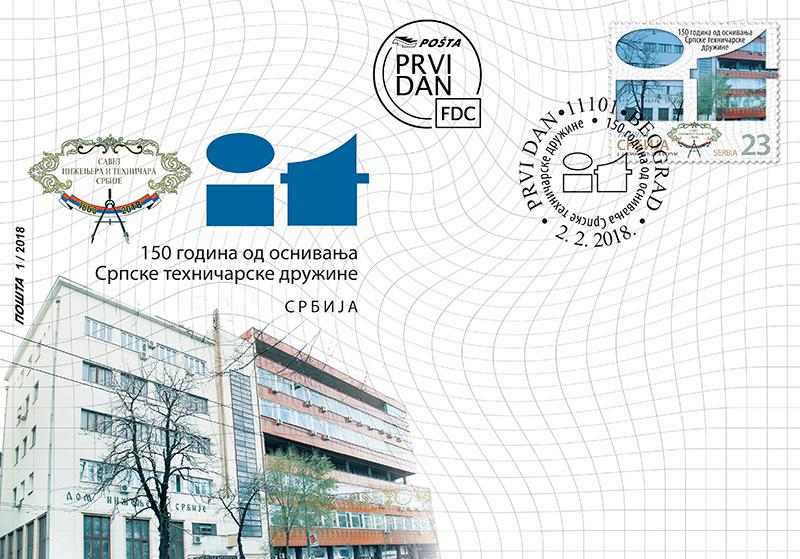

The roots of Serbian technical civilisation lie in the middle ages, during the reign of the Nemanjić dynasty. The beginnings of engineering are visible in mining and metallurgy ventures such as Novo Brdo mines, and in the construction of resplendent sacral and other buildings. The renewal of the Serbian statehood after the centuries-old Ottoman power, and the creation of a modern state in the nineteenth century, revived the Serbian engineering as well. At the time, the engineers were predominantly educated in the Austro-Hungarian Empire and France. The “Engineering Society”, the forerunner of our Union of Engineers and Technicians of Serbia, was established already in 1868, on 3 February. During its long 150 years, the Engineering Union went through many changes, but has always been active and socially recognisable. Many important engineers and scientists of all professions were, and still are, its members. The first chairman was Emilijan Josimović, an architect and urbanist, and Nikola Tesla was a prominent honorary member.
A very important moment in the activity and affirmation of the Union came with the construction of the House of Engineers of Serbia in 1936, and of the New House of Engineers “Nikola Tesla” in 1967. The funds for construction were provided by engineers, businessmen and benefactors; the engineering intellectuals demonstrated their importance and determination for gathering and action through their associations and the Union as the expressions of their professional, scientific, intellectual and critical engagement. Today, the Union has more than forty professional, multidisciplinary, thematic, city-wide and regional members. It encompasses a Development Centre and the Engineering Academy of Serbia. The activities are diverse: gathering, debates, conferences, publishing, cooperation with other professionals and their associations, licencing examinations, exhibitions, academic work with university and secondary school students and young researchers. The Union has several thousand members from all the cities and municipalities in Serbia. The Union itself and its members are self-financed non-governmental organisations, providing funds from their activities and membership fees. The Union has large societal significance and role both in Serbia and in wider European and global engineering community, which is manifested in our membership in international related organisations and in the national environment, through affirmation of knowledge and cooperation with other associations, public bodies, businesses and schools, and, in particular, in the number and quality of our members.
Motif on the stamp and FDC: Trademark and jubilee logotype of Serbian Technicians’ Society; House of Engineers of Serbia and the New House of Engineers ”Nikola Tesla”.
Graphic realization of the stamp: Jakša Vlahović, academic graphic artist.
Expert collaboration: Dr. Igor Marić, Chairman of the Union of Engineers and Technicians of Serbia.
XXIII Olympic Winter Games – PyeongChang 2018
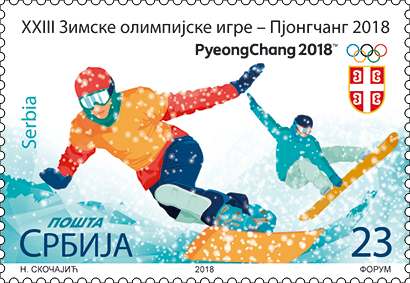
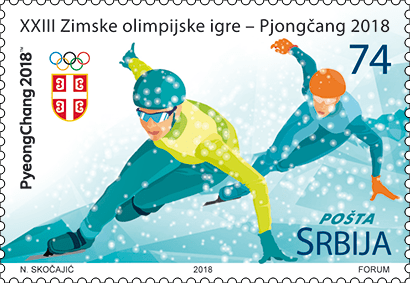



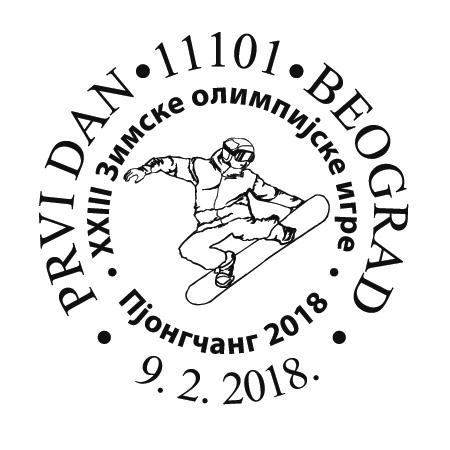
The First Winter Olympics were held in Chamonix in 1924 as the ”International Winter Sports Week“ and the name Olympic Winter Games was introduced in 1925 at the International Olympic Committee (IOC) Congress held in Prague. Two hundred and fifty-six athletes from 16 countries took part in 16 events at the Chamonix Games, while 2,780 athletes competed in 98 events during the last Winter Olympics in Sochi 2014.
XXIII Winter Olympic Games will be held in PyeongChang, Republic of Korea from 9th till 25th February 2018. This is the first time that a city at the Korean Peninsula was chosen to be the organiser of the Olympic Winter Games while Seoul was the host city of the 1988 Summer Olympics. The host city of the XXIII Winter Olympic Games was chosen on July 6, 2011 by IOC at the Session held in Durban. The other candidate cities were Annecy (France) and Munich (Germany). The 2018 Winter Olympics will feature 102 events in 15 sports. New disciplines that will be introduced at this edition of the Games are Nations Team Event in Alpine Skiing, Big Air Snowboarding, Mass Start Speed Skating and Mixed Doubles Curling.
The official motto of the Games is Passion. Connected and is related to the world where everyone is connected by great passion for the winter sports.
The official mascot of the Games is Soohorang, a white tiger, considered to be a guardian animal of Korea. Its role is to be a trustworthy friend protecting the athletes, spectators and all participants of the Winter Olympics.
Artistic realization of the stamps: MA Nadežda Skočajić, academic graphic artist.
Expert collaboration: Olympic Committee of Serbia.
Lunar horoscope - Year of the Dog






The lunar calendar is based on cycles of lunar phases, although most of the lunar calendars are actually lunisolar calendars. This means that the calendar months correspond to lunar cycles; however, intercalary months are occasionally added to harmonize these cycles with the solar year. Among these calendars are Chinese, Hebrew and Hindu calendars, as well as most calendar systems used in ancient times. Lunar calendars differ according to which day the month begins. In the Chinese calendar, the first day is astronomically determined by the conjunction of the Sun and the Moon in the Chinese time zone.
Chinese Zodiac belongs to the oldest known astrological systems. It consists of 12 signs, each of which rules over one lunar year. These zodiac signs bear the names of animals (Rat, Ox, Tiger, Rabbit, Dragon, Snake, Horse, Goat, Monkey, Rooster, Dog and Pig). In addition to the basic signs, elements are also quite important in Chinese horoscope: wood, metal, water, fire and earth. Chinese astrology is based on the knowledge of ancient astronomers and the traditional Chinese calendar. It is also associated with ancient teachings about three harmonies – heaven, earth and water, Wu Xing teachings, Yin and Yang, five planets, 10 celestial streams and 12 earth branches, etc.
In the lunar horoscope, 2018 is the year of the Earth Dog and it begins on February 16th. It is believed that people born in this sign are loyal and honest, kind, reasonable and cautious. The dog will do everything for a person he considers important in his life. Good-natured, Dog greatly appreciates peaceful family life and good relationships with the loved ones. He is always willing to help and does not care about his own interests, but if you betray him, he will be shocked and hurt.
Since astrology belongs to the corpus of esoteric teachings, two general archetypes are presented on the stamps, not specific breeds of dogs. One is based on the traditional Chinese portrayal of a guard dog that often bears iconological resemblance to the lion. The other stamp shows a typical Western depiction of a dog - a shepherd, who, out of all breeds, looks most like a wolf, while an archetypal pet dog is shown on the envelope, which serves the purpose of amusement for family members.
Artistic realization: MA Boban Savić, academic painter.
Easter
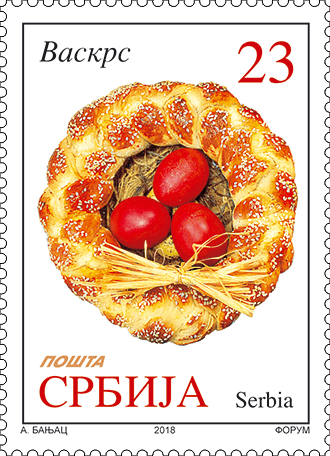





Easter Sunday is the date of the annual celebration of Christ’s resurrection. The Orthodox Church celebrates the Easter on the basis of the Julian calendar. The date is not fixed, but denotes the same season of the year and the same relationship to the preceding astronomical full moon that occurred at the time of His resurrection in 30 A.D.
Easter is one of the most important Christian holidays. This is a day of eternal joy, the day when Christ, the Son of God, conquered the death. By the act of resurrection Jesus Christ proved his divine power and opened the gate of eternal life, joy and happiness that we can find in our faith. On Easter Sunday morning the church bells toll, and the people, together with their priest, go around the church. After the third round they stand in front of the church door. The priest carries the cross, candle and the censer and chants the Easter hymn. The door open and they enter the church where liturgy continues. When it ends, people greet each other with the words: “The Christ has resurrected”, and “Indeed he has”. There are many customs connected with Easter Sunday, and certainly one of them that children like best, is colouring and offering of eggs. The first egg is coloured red and in many parts of our country it is called “The house keeper” and is kept for the whole year, until the next Easter.
Artistic realization of the stamps: Anamari Banjac, MA academic painter.
150th anniversary of the National Theatre in Belgrade
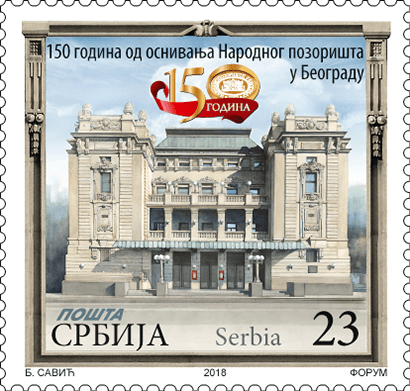

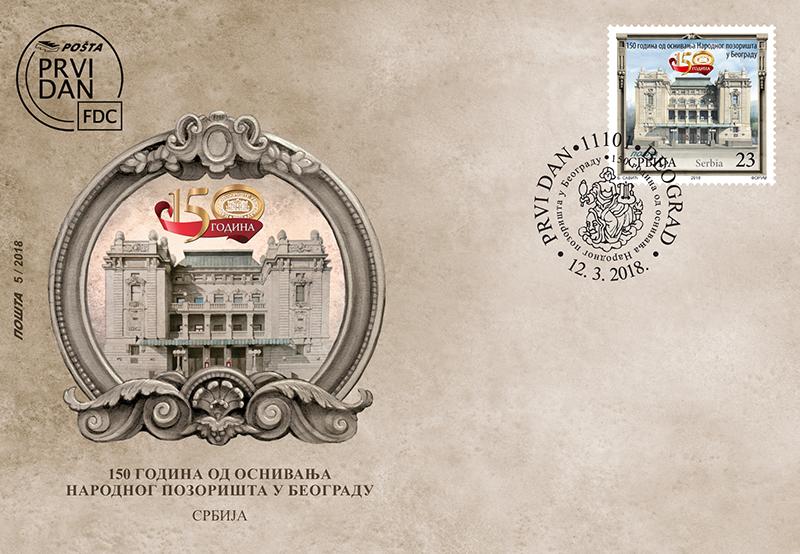


When the National Theatre in Belgrade was founded 150 years ago, Serbia had the population of a little more than a million and two hundred thousand people. At the time, Belgrade’s population had just risen above 25,000 residents, living in 3,444 houses. In 1860s, Belgrade was just a large village, halfway between the Ottoman Empire and the European civilisation.
After several attempts to create a permanent professional theatre in Belgrade that dated back to 1842, short-lived but undoubtfully showing that the theatre was necessary in this country and its capital, the National Theatre was founded in 1868 in Belgrade.The first play – Đurađ Branković by Karolj Obernjak, was performed on 22 November 1868 in At the English Queen inn that became the temporary home of the National Theatre for the next year.
Then, upon foundation of the National Theatre, Prince Mihailo Obrenović and the State Council determined the new site for the theatre building – the former Turkish lot near the Stambol Gate. The Prince also started the donations by giving five thousand ducats. Unfortunately, he did not live to see the start of works, as he was assassinated on 3 June 1868. The keystone was laid by the Prince Milan instead. In the spring of 1868, the auction for construction works was organised, and the works awarded to E. Steinlechner. The construction was completed very quickly. The works started on 29 May, the keystone was laid on 18 August 1868, and the building was under roof as early as January 1869. In the city of 25,000 citizens, the theatre hall had some 800 seats. The first performance in the new building was given on 30 October (by Julian calendar) of the same year. That was the play Posthumous Glory of Prince Mihailo, a picture of life of ordinary people by Đorđe Miletić.
Today, the National Theatre in Belgrade, attracting the audience of 150,000 spectators per year, plays two simultaneous performances on two stages every day. It is unique and the most significant cultural institution in Serbia that hosts ensembles of drama, opera and ballet, choir and orchestra.
Artistic realization: MA Boban Savić, academic painter.
Expert collaboration: National Theatre in Belgrade.
Fauna






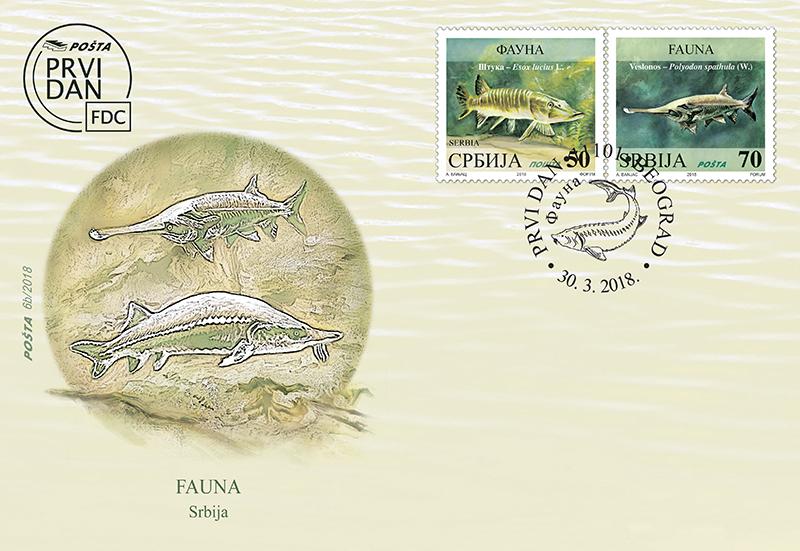

Sterlet – Acipenser ruthenus L.
Sterlet is the smallest sturgeon species in the Danube, reaching up to 125 cm in length and weighing up to 16 kg. Its body is olive–gray, the back being darker, and the hips brighter. It differs from its relatives in that it does not migrate to the sea. It spends its entire lifetime in the river, usually in the main current zone, and during winter stagnation it stays in the deep depression of the river bed.
It feeds on invertebrates from the bottom, primarily the insect larvae. Sterlets spawn from April to June in the fast water currents above the gravel bottom. One fish can lay over a hundred pieces of roe. It reaches full maturity at about 4–5 years of age, and its life expectancy is about 25 years. They are extremely commercial and are net–fished already from the early spring.
Sturgeon (Beluga) – Huso huso (L.)
Sturgeon belongs to the family of Acipenseridae. These are the biggest fish of the Danube. They reach a length of up to 9 m and weigh up to 2,000 kg. They spend most of their lives in the sea, where they live at depths of 70–180 m and at a distance of up to 12 km from the coast. They feed on fish, anchovies, goatfish, small flatfish, gobii, but also crabs and molluscs. During the spawning period, in March or autumn, they migrate from the Black and Caspian Sea to the great rivers. They also inhabit the Danube, looking for a suitable habitat for their spawn – gravel or rocky bottom with a strong flow of water. Females lay up to 100 kg of roe from which high quality caviar is made. Prior to the construction of the second Djerdap dam, sturgeons in their upstream migrations came all the way to Bratislava. With the construction of the dam, their route was interrupted. Due to excessive fishing and the spawning being disabled by the interruption of the migration route, the number of sturgeon population has been reduced to a minimum. They are placed under protection in every area they inhabit. In Serbia, according to the IUCN list, they have the status of EN–type in danger of disappearing. This status is obtained by the species for which there is a high possibility of disappearing in the future, in their natural surroundings.
Pike – Esox lucius L.
Pikes are recognizable by the cylindrical shape of their body, with a back fin placed far back, close to the tail fin. The head has strong jaws, full of sharp teeth that are different in appearance depending on the position. Pike inhabits stagnant and slow–moving fresh waters of Eurasia and North America. Pike is a predator fish and is considered to be the best ambush hunter. Its elongated body, covered with small scales, is a true muscular spring, which allows the initial acceleration of up to 11 m/s, which is the record among the fish. However, their maximum swimming speed is not as impressive and it does not exceed 60 km/h. This suggests that the pike is not a persistent predator and in the event of an unsuccessful attack, it will quickly give up on further chase after its pray. Pike is among the first fish to spawn, already around the end of winter which, in our climate, means from February to April. It spawns starting from about 3–4 years of age. The female, depending on its size, lays 16–75 thousand pieces of roe, whose incubation after the fertilization lasts for about 10–15 days. Pike is a longevous species that can live up to 40 years.
The American Paddlefish – Polyodon spathula (W.)
The American Paddlefish is widespread across the United States, in the Mississippi River Basin, including the rivers Missouri and Ohio, as well as their tributaries. It inhabits the slow flowing rivers and can usually be found at depths greater than 1.5 meters. It arrived in the European rivers not so long ago, from the spawning and nursing grounds which accidentally poured out. The American Paddlefish can grow up to 2.2 m in length and can weigh up to 90 kg, and its life span is about 55 years. Females reach full maturity at the age of 9 and males at the age of 6. The main characteristic of the American Paddlefish is its growth on the upper jaw resembling a construction tool, which is why it is commonly known as – spatula. The American Paddlefish feeds on planktons. Adult specimens do not have teeth. It is appreciated for its delicious meat and roes from which caviar is made. It is related to our sturgeon species (Acipenseriformes). Just like the sturgeon, the American Paddlefish has a cartilaginous skeleton, its body is smooth and without scales, and on their lips they have four barbels.
Expert collaboration: Dubravka Mićković, curator.
Natural History Museum in Belgrade.
Artistic realization of the stamps: MA Anamari Banjac, academic painter.
Cities of Serbia



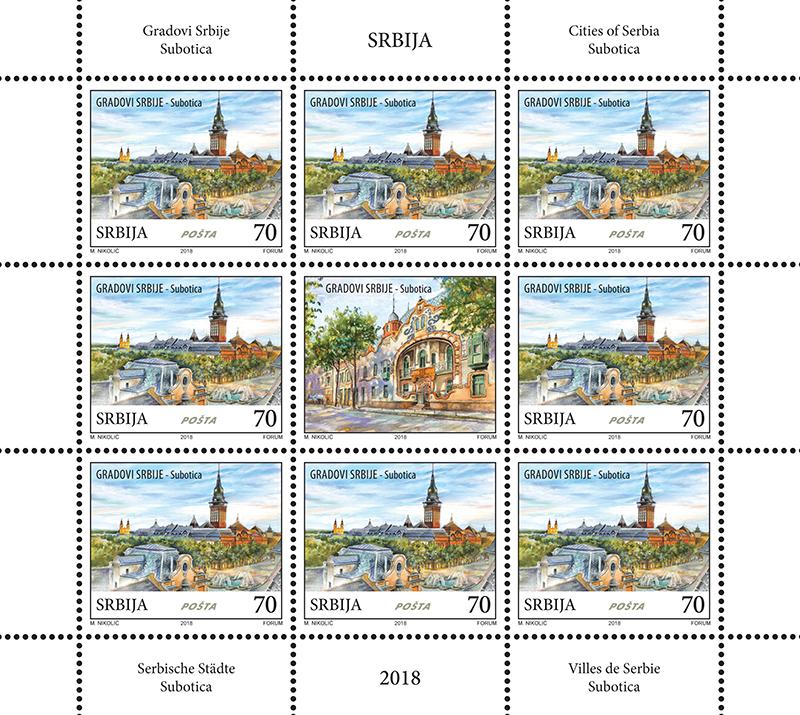





Kragujevac
Today, Kragujevac is the seat of the Šumadija District, and in the 19th century, during the reign of Prince Miloš Obrenović, it was the capital of the Principality of Serbia. The Old Church in Kragujevac is a cornerstone of modern Serbia, built in 1818 as a metropolitan church in whose yard the very first Serbian Constitution was adopted on the Feast of Candlemas in 1835. Just next to the church, the building of the Old Parliament was erected in 1859, where the provisions of the Berlin Congress were promulgated in 1878. Serbian interests at the Congress that made Serbia internationally recognised independent country were represented by Jovan Ristić, a Kragujevac-born diplomat and Minister of Foreign Affairs.
At the end of 19th and in early 20th century a new business district was constructed in Kragujevac, under the architectural influence of Budapest and Vienna. The new buildings have characteristic street fronts with filigreed ornamental wreaths. The Moscow block was built at the beginning of 20th century, introducing the Secession style to the city centre. The County Administration Palace, built in the very centre of the city, is one of the most beautiful public buildings in Serbia dating from early 20th century. Serbian industrial development begins with the construction of Gun Foundry in Kragujevac in 1851. In the interwar period, the Old Workers’ Colony district was built for the needs of the Military-Technical Institute, hosting at its centre a square with imposing Sokolana edifice built in 1929. The very first incandescent bulb in Serbia had shone in the building of the Old Bullet Case Factory, seven years before the electricity came to the palace. Today, the building of the Gun Foundry is the home of the Old Foundry Museum.
After the First World War, it was here that the building car manufacture and repair started, which grew into the largest automotive manufacturer in the SEE region after the Second World War: Red Flag Works.
Kragujevac is also the home of the oldest Serbian grammar school, with the Princely Serbian Theatre in its vicinity. Both institutions were established by Prince Miloš Obrenović: the grammar school in 1833 and the theatre in 1835.
Big Park, the favourite promenade of the people from Kragujevac was developed in the 19th century, using French parks as pattern, and is connected to the Šumarice Memorial by a pedestrian pathway.
Motifs: stamp – Kragujevac, old city centre; vignette – Jovan Ristić Square; FDC – Big Park.
Expert collaboration: Snežana Milisavljević, Director of the City Tourist Organisation “Kragujevac”.
Artistic realisation: Miroslav Nikolić.
Subotica
The City of Subotica is located on the north of the Republic of Serbia, along the main European corridors and between two rivers, the Danube and the Tisa. Rich cultural heritage assets, lavishly decorated buildings in Art Nouveau style, by which is Subotica well known, multicultural spirit and European charm – these are the features that make this city distinctive. Subotica is known for its relaxed atmosphere, good food and quality wines. Festivals, events, concerts, vibrant cultural life all year long are a reason more to visit this city. On top of that, Subotica offers a lot of interesting places for rest and leisure, for activities around the lakes, on horse-farms, farmsteads, in forests and hunting areas.
Palić, the lake and the settlement by the same name are 8 kilometres east of Subotica. Palić offers something new, unrepeatable and enriching at any season. Outstanding facilities from the beginning of the 20th century: the Water Tower, the Grand Terrace, the Women’s Lido and the Music Pavilion, the splendid park, the well-known lake, peace and silence, make Palić an ideal space for rest and relaxation. Currently Palić provides high category hotels, regenerated luxury and comfortable villas in the so called ”Palić style”, several lodgings and private boarding houses. Excellent restaurants and cafés, sport and recreational fields, three arranged beaches, a thermal pool, a Zoo, cycle lanes, walking paths, a set of versatile events, dynamic cultural life and entertainment possibilities and contents comprise the comprehensive offer of the Palić Tourist Centre.
Motifs: stamp – Panorama of Subotica with the motive of the Town Hall and Synagogue; vignette – Ferenc Raichle Park with the Modern Art Gallery building, built by Ferenc Raichle; FDC – Palić lake.
Artistic realization of the stamps: Miroslav Nikolić
Expert collaboration: Nešo Radulović, Acting Director, Subotica Tourist Organization.
200 years since the publishing of the Serbian Dictionary by Vuk Stefanović Karadžić




Serbian Dictionary, in German and Latin Words.
Collected and made public by Vuk Stefanović.
The Serbian Dictionary (Srpski rječnik) by Vuk Stefanović Karadžić was printed in the printing house of the Armenian Monastery in Vienna in 1818. It contains 26,270 words used by people in Serbia, Srem and Vojvodina. The words are interpreted (translated) into German and Latin descriptions and expressions.
The Serbian Dictionary (Srpski rječnik) by Vuk Stefanović Karadžić was printed in the printing house of the Armenian Monastery in Vienna in 1818. It contains 26,270 words used by people in Serbia, Srem and Vojvodina. The words are interpreted (translated) into German and Latin descriptions and expressions. As early as 1815, Vuk Karadžić started to collect materials for the Serbian Language Dictionary, as suggested by Jernej Kopitar (1780–1844), the Censor for Slavic Languages at the Vienna Court Library. During 1815 and 1816, Vuk lived in the Šišatovac Monastery where, assisted by his friend, poet Lukian Mušicki (1777–1837) analysed words that would find their place in the Dictionary. The manuscript was completed already in 1816, but because of the lack of means and the polemic with the opponents, the Dictionary was published in 1818. The Dictionary comprises the foreword, a list of praenumeration subscribers, grammar and table with Serbian, several Slavic and western alphabets for purposes of inter-comparison. The Dictionary itself was entirely printed two-column, and has 928 columns. Vuk wrote the foreword of the Dictionary in the form of treatise addressed to his opponents in polemic. The date of the Foreword is 10 October 1818. Vuk was aware of the deficiencies in the first edition of the Serbian Grammar printed in 1814, and published the second, extended edition thereof in his Serbian Dictionary. Thus, the first edition of the dictionary became one of the crucial steps in the struggle for language, because it laid the pure people-spoken, popular language as the foundation for the literary language. Only six years later, in 1824, the second edition of the Serbian Grammar was translated into German language by Jacob Grimm (1785–1863), a German writer.
Artistic realization of the stamp: MA Marija Vlahović, academic graphic artist.
Expert collaboration: Eliana Gavrilović, MPhil, Museum of Vuk and Dositej, Belgrade.
Europa – Bridges

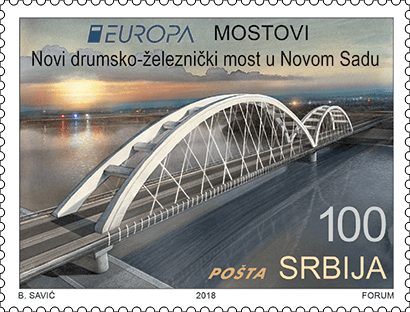




"Gazelle", the bridge which is crossed by almost 165,000 vehicles daily, is the busiest Belgrade bridge which connects the two banks of the Sava river. Thanks to its unusual construction, the bridge in profile resembles a running gazelle, hence the name "Gazelle". Its construction is a combination of beam and arc systems, it has no classical arc to be carried by, but it does not stand on pillars, which is a solution applied for the first time on this bridge. The construction of the bridge was performed by the enterprise "Mostogradnja" from Belgrade, in cooperation with "Goša" from Smederevska Palanka, and the bridge was solemnly opened on 4 December 1970. During the load testing of the bridge, for which the then Yugoslav National Army was engaged, there were on the bridge, according to the old chivalric custom – the main architect, professor of the Faculty of Construction Milan Đurić and the Belgrade mayor Branko Pešić. "Gazelle" is a combination of beam and arc, it is 332 m long, and 27.5 m wide. Total width of the driveway is 21.8 m. On one part of the bridge there are two pedestrian paths, each being 3 m wide. "Gazelle" rises 22.8 m above the Sava during the middle water-level.
The new Road and Railway Bridge in Novi Sad was built where "Žeželjev" bridge once stood – the road and railway bridge of concrete and arcs on the Danube river, between Novi Sad and Petrovaradin, built in 1961 and demolished during the NATO bombing on 23 April 1999. The main architect of the new bridge, engineer Aleksandar Bojović constructed the bridge which shares numerous common points with the original solution of engineer Žeželj. The new bridge has two railway tracks, two road tracks and two pedestrian paths; it leanes on five pillars and it consists of four simple beams of harnessed beam constructions with 27 m and 48 m spans and steel arc construsctions with 177 m and 219 m span, respectively. The driveway construction of all the spans is harnessed steel and concrete. This bridge is now 474 m long, 220 m of which belong to the big arc, 180 m to the small one, and there are also two access bridges – one, 48 m long, from the side of Novi Sad, the other 26 m long, from the side of Patrovaradin. The big arc bridge weighs 6.400 tons, and the small one 4.800 tons, while the width of the bridge is 31.60 m.
Artistic realization of the stamp: Academic painter Boban Savić, MA.
Expert collaboration: Dean of the Faculty of Construction Branko S. Božić, PhD.
Museum exhibits - 95 years since the founding of the PTT Museum





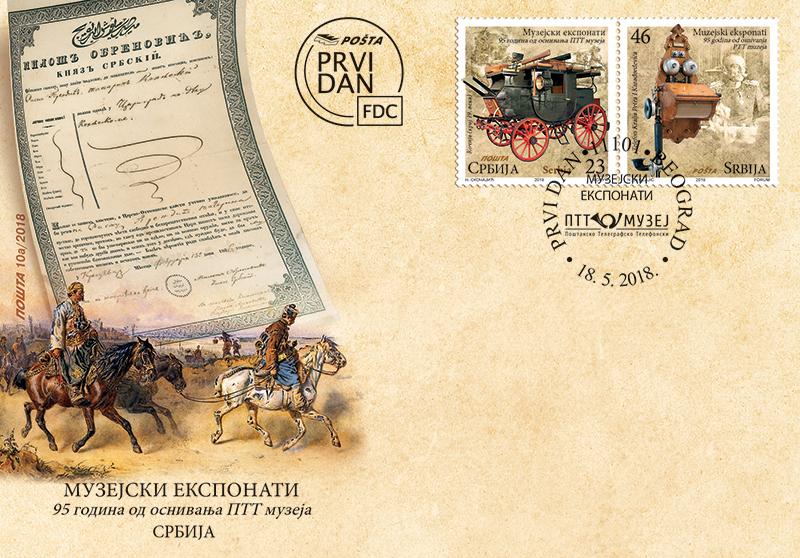


Postal-Telegraphic-Telephone Museum in Belgrade functions as a museum within the Public Enterprise Post of Serbia. Being a technical museum, it deals with the protection, collection, study and exhibition of objects and documents related to the operation and development of postal, telegraphic and telephone communications.
PTT museum was founded on July 31, 1923, when the Ministry of Posts and Telegraphs of the Kingdom of Serbs, Croats and Slovenes adopted the Museum Rulebook. At the beginning, the fund of the PTT Museum was in the building of the Ministry of Posts and Telegraphs in 49, Deligradska Street and from the year 1930 it was located on the fifth floor of the newly built building of the Ministry in 2, Palmoticeva Street, but it was not open for public.
Significant time for PTT museum was the period from 1950 until the museum was opened for visitors in 1958, when the intensive works were done on collection, organization, systematization and scientific processing of archival materials and exhibits.
PTT museum was officially opened for public on June 14, 1958, and the exhibit was realized in accordance with the contemporary state-of-the-art concepts of the museum's presentation.
Realizing the importance of the museum as an institution, PE PTT communications Serbia started the project of reconstructing the museum and new permanent museum exhibition in 2010. Reconstruction included the whole museum exhibit space, depots for exhibit storage and museum library, and everything was done in accordance with the latest museum standards for exhibiting and preserving museum exhibits. At the same time, the most modern audio and video equipment was purchased for the needs of presentations, lectures and workshops within the museum.
The museum exhibition is divided into six sections and it represents a chronological overview of the development of PTT communications from 1815 to now, with various exhibits that interdependently and mutually illuminate the social, cultural and economic history in addition to the history of communication of the modern Serbian state. New, reconstructed museum space and new permanent exhibition were officially opened for public on June 7, 2013.
Expert collaboration: Postal-telegraphic-telephone Museum, Belgrade.
Artistic realization: Nadežda Skočajić, Academic Graphic Artist
Art



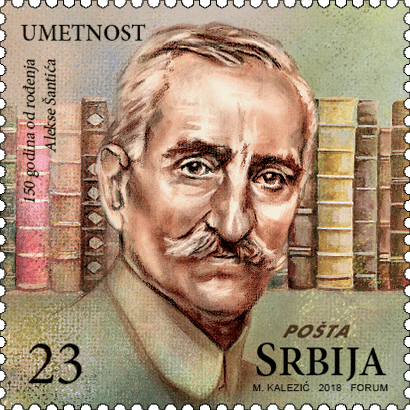








200th Anniversary of the Birth of Ivan Sergeyevich Turgenev
The most important representative of Russian realism, Ivan Sergeyevich Turgenev, a short story writer and novelist, was born on 9 November 1818 in Orel, not far from the city of Mcensk.He dealt with all genres of literature and achieved enviable success, especially with novels, but above all he was a short story writer, unsurpassed in lyric storytelling. His first work, a poem Parasha was published in 1843. He depicted a realistic life of Russian serfs and their masters, which brought him troubles with authorities. Regarding the death of Nikolai Gogol he wrote and printed a necrolog, despite the ban, which was the reason he was sentenced to a month’s imprisonment, although the main motive for that action was his collection of short stories A Sportsman’s Sketches. His famous works are the collection of short stories A Sportsman’s Sketches (1852), novels Rudin (1856), A Nest of the Gentry (1859), Fathers and children (1862), as well as the collection of Songs in Prose (1878). Along with Dostoevsky and Tolstoi he made a contribution to Russian literature in a way that it received a world status, and his novel Fathers and children is considered to be one of the most important novels of the 19th century. He died on 3 September 1833, in Bougival, France.
175th Anniversary of the Birth of Kosta Trifković
Kosta Trifković, a writer, was born on 20 October 1843 in Novi Sad. He graduated from Grammar school in Rijeka, and studied law in Debrecin, Pozun and Kosice. He was employed as a city notary and senator in Novi Sad, and was also engaged in advocacy. He was a supporter and associate of Svetozar Miletić’s National Party. He was a vice president of Matica Srpska, and helped the work of the Serbian National Theatre in Novi Sad wholeheartedly; he also renewed the literature review Javor. While still in Grammar school, he wrote poems in the tradition of Branko Radičević and plays under the influence of Moliere, but his genuine vocation was comedy ― he was a creator of one-act plays The Franco-Prussian War (Francusko-pruski rat), On Christmas Eve (Na Badnji dan), Congratulations (Čestitam), The Overseer (Školski nadzornik), as well as the merry three-act play The Choosy Bride-to-Be (Izbiračica). Although he was the successor of Jovan Sterija Popović, Trifković did not continue his comedy thread. Instead of comedies of character, Trifković wrote plays after the fashion of modern French comedians, cherishing a new form of comedy, the comedy of intrigue. He died in Novi Sad on 19 February, 1875.
150th Anniversary of the Birth of Maksim Gorky
Aleksei Maksimovitch Peshkov, better known as Maksim Gorky, was born on 28 March 1868 in Nizhny Novgorod. He became an orphan as a very young boy, so he lived with his grandparents. His grandfather used to beat him and he was very soon trown out to the street.
Although he was a self-taught writer, Gorky created works which made him one of the most translated Russian writers in the world literature. He was a five-time nominee for the Nobel Prize, but he never won one.
His first short story Makar Chudra was published in 1892, when the pseudonym Maksim Gorky was created. His most famous works are short stories Two Vagabonds, The Old Lady Izergil and Chelkash, Konovalov, lyric poem Song of a Falcon and a lyric poem in prose The Song of a Stormy Petrel, plays Philistines, The Lower Depths, Summerhouse, Children of the Sun, Yegor Bulychov; novels Foma Gordeyev, Three of Them, A Confession, Okurov City, The Life of Matvei Kozhemyakin, My Childhood, My Universities, The Artamonov Business, Life of Klim Samgin. He wrote his most important and most famous work, the novel Mother, in 1907 while in exile.
He was considered to be a moral and righteous man. He defended the interests of the poor and fought for greater labour rights, and the truth was the ideal he strove towards. He contributed to the creation of socialist realism as art style.
He died on 18 June 1936, in Moscow.
150th Anniversary of the Birth of Aleksa Šantić
Aleksa Šantić was born in Mostar, on 27 May 1868. His father died when Aleksa was a little boy, so he lived with the family of his uncle. He studied to become a trader in Ljubljana and Trieste, and returned to Mostar in 1833 and started working in his late father’s shop.
He published his first poem in 1886, and the first collection of poems in 1891. He collaborated in journals Golub, Bosanska vila, Nova Zeta, Javor and Otadžbina (Homeland). In 1888 he established Serbian Singing Society Gusle, being its first president, and when the magazine Zora was started in 1896, he was one of its first editors - in - chief.
A poet of patriotism, nationally and socially destitute Serbian people, but also of emotional pain and love yearning, Šantić created his greatest works ― poem Hasanaginica, collection of poems At the old Hearthstones (Na starim ognjištima), plays in verse Anđelija, Nemanja and In the fog (Pod maglom), poems Emina, Don’t Trust (Ne vjeruj), Stay Here (Ostajte ovdje), Eve of the Festival (Pretprazničko veče), Što te nema?, An Evening on a Small Island (Veče na školju), O klasje moje, My Homeland (Moja otadžbina), We Know Our Destiny (Mi znamo sudbu), Boka, Under the Cross (Pod krstom), The Blacksmith (Kovač) at the turn of the 19th and 20th century.
His role models were Vojislav Ilić and Jovan Jovanović Zmaj and of the foreign writers he esteemed Heinrich Haine the most. He became a corresponding member of the Serbian Royal Academy on 3 February 1914.
He died in Mostar, on 2 February 1924.
125th Anniversary of the Birth of Miloš Crnjanski
Miloš Crnjanski, a writer, essayist and journalist, was born in Csongrad, on 26 October 1893. He finished primary school in Pančevo and Grammar school in Timişoara. In 1913 he went to study at the University in Vienna, but the next year he was mobilised and, as a Austro-Hungarian soldier, he fought in Galicia. After the war, he enrolled in the literature studies. In 1920 he graduated from the Faculty of Filosophy in Belgrade. The same year he became one of the editors of the Novi Sad magazine Dan. Along with his two poems Sumatra and Rocks (Stenje), in 1920 he also published a lyric manifest of the new poetry - An Explanation of Sumatra (Objašnjenje Sumatre) in Serbian Literary Herald. He published the poem Stražilovo in 1921. Crnjanski belongs to the generation of the first post-war modernists in Serbian literature, and his novels Journal of Čarnojević (Dnevnik o Čarnojeviću, 1921), Migrations (Seobe, 1929) and A Novel about London (Roman o Londonu, 1972) are among the most important works of Serbian literature. From 1923 he was first a journalist of Politika and then of Vreme. In 1928 he became a press attache at the Embassy of the Kingdom of Yugoslavia in Berlin. After the outbreak of the World War II he emigrated to London, and returned to Yugoslavia in 1965. He died on 30 November 1977. He was buried at the Alley of the Greats at the New Cemetery in Belgrade.
100th Anniversary of the Birth of Aleksandr Solzhenitsyn
Aleksandr Isayevich Solzhenitsyn, a Russian writer, Nobel Prize winner and dissident, was born in Kislovodsk, on 11 December 1918. Besides being a writer, playwright and historian, he was also a member of the Serbian Academy of Sciences and Arts since 1994, and a member of the Russian Acedemy of sciences since 1997. He studied at the Faculty of Physics and Mathematics in Rostov-on-Don. After the outbreak of the World War II he voluntarily joined the Army and advanced to the rank of the Commander of the Artillery Brigade, but was arrested in 1945 because of the letters in which he indirectly criticised Stalin, and as the Officer of the Soviet Army he was expelled from the battle-field straight to Siberia. He was rehabilitated in 1956 but was prosecuted again later, and his citizenship was even taken away from him, so he emigrated in 1974. He came back to Russia only after two decades. His work was marked by the experience from the Siberia concentration camps, which he introduced as a theme into literature. His most famous works are The Gulag Archipelago, short stories One Day in the Life of Ivan Denisovich, Matryona’s Place, novels The First Circle, Cancer Ward, August 1914, The Red Wheel, Russia in Collapse, a critical autobiography The Oak and the Calf, plays The Feast of the Winners, Prisoners, The Light in You… Solzhenitsyn won the Nobel Prize for literature in 1970, being the most prominent person of the literary resistence towards the Soviet totalitarism. He died in Moscow, on 3 August 2008.
Artistic realization of the stamps: MA Marina Kalezić, academic painter.
European nature protection






"Waterfalls of Sopotnica" Natural Monument
The Sopotnica waterfalls are located in southwest Serbia, in the area of the village bearing the same name, close to Prijepolje and on the western slopes of the Jadovnik Mountain. In the spring part of the river Sopotnica, at a length of about 500 m, mighty deposits of tuff are placed in the form of flatted fan-like terraces. The terraces are arranged in six levels, and are separated from each other by sections of different slopes and heights. Between the first, the lowest, and the other terrace, there is also the largest, 20 meters high, waterfall. Waterfalls of Sopotnica are considered the richest water in Serbia.
The Government of the Republic of Serbia, on the basis of the Study of Conservation developed by the Institute for Nature Conservation of Serbia in 2005, adopted the Decree and proclaimed the Monument of Nature – Waterfalls of Sopotnica protected natural good of category I and of exceptional significance.
Sava Simić PhD, Institute for Nature Conservation of Serbia
"Cerje Cave" Natural Monument
The Cerje Cave Natural Monument is located near the city of Niš in eastern Serbia. The Cerje cave is a complex underground karst system developed along a canal in several levels, with diverse cave ornaments and complex diversity of the cave fauna. A special value of the cave represent rare cave ornaments – helictites which, contrary to the physical laws and gravity, are formed and stretched in all directions due to the influence of specific crystalisation processes. New discoveries at the Cerje Cave Natural Monument found the connection of the cave to the Kravljanska pit. With the newly-discovered canals, the length of the Cerje cave system is 7.149 m, which makes it the second longest cave in Serbia.
On the basis of the Study of Conservation of the Institute for Nature Conservation of Serbia, the Government of the Republic of Serbia passed a decree on the Conservation of the Cerje Cave Natural Monument in 1998, protecting the cave as a natural good of exceptional importance of the I category.
Dragan Nešić, PhD, Institute for Nature Conservation of Serbia.
Artistic realisation: Miroslav Nikolić.
2018 FIFA World Cup Russia

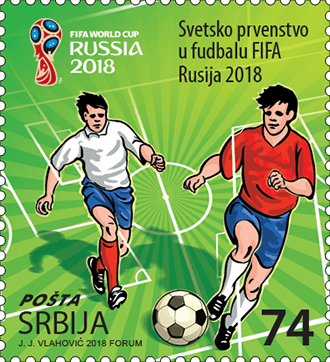






After eight years of non-participation, Serbia has managed to earn its place in a big tournament, and what makes this success even greater is knowing that, by qualifying for the World Cup in Russia, our team is once again among the 32 top teams in the world. Ivanović and his teammates treated the nation with excellent matches on their way to Russia, completed qualifications by winning against the Republic of Ireland, Wales and Austria, and the entire nation hopes to show, at the summit of the best national teams on the planet, that Serbia is in the company in which it deserves to be. At the World Cup in Russia, our national team, led by Mladen Krstajić, will be placed in the Group E along with Brazil, Switzerland and Costa Rica.
Our first game is scheduled for June 17 in Samara, where our rival will be Costa Rica. Five days later, in Kaliningrad, our Eagles are expecting a duel with Switzerland, and a real treat for the football planet will be an encounter between Serbia and Brazil, scheduled for June 27 in Moscow. Two first-placed teams will compete in the World Cup knockout phase. The first appearance of independent Serbia was at the 2010 World Cup in South Africa, where we made a historic victory against Germany, but due to a series of unfortunate circumstances and unexpected losses from Ghana and Australia, we were unable to pass the group stage. Back then and even now, our ambitions have always been great, thanks to our tradition and mentality. Our dream, of course, is to make a little wonder and repeat the success that Yugoslavia once achieved at the first World Cup in Uruguay in 1930 when we won the third place, or 32 years later when Šekularac and his teammates took the fourth place in the world.
The World Cup in Russia will be, according to the host’s announcement, as well as FIFA’s, the best organized Cup ever. New stadiums, huge interest of fans around the globe, and the biggest names of world football guarantee an outright spectacle. Serbia wishes to show itself in the proper light with our players from strong European leagues, those who are hungry for success, and playing in jerseys with their favourite coat of arms. Therefore, we hope that, during the World Cup in Russia which will be held from June 14 to July 15, the entire nation will be one with its national football team. For Serbia in Russia!
Expert collaboration: Football Association of Serbia.
Artistic realization of the stamps: MA Jakša Vlahović, academic graphic artist.
Children’s Stamp – Baby Zoo








The Belgrade Zoological Garden welcomed its first inhabitants back in 1936, and today it spreads over an area of seven acres of the Belgrade Fortress, and has more than 200 species and 1200 animals. According to the number of natural reproductions, the Belgrade Zoo is at the very top of Europe today.Baby Zoo, within the Belgrade Zoo, was built in 1995 and has been home to various types of baby animals for years. It instantly became a favourite place for visitors, especially the youngest ones. They can see babies of all kinds here and sometimes even have direct contact with some of them. Here, children can play with baby goats, raccoon babies, baby servals, and various other species to whom the Baby Zoo is a temporary home.
Patagonian mara (Dolichotis patagonum)
Patagonian mara is a large South American rodent that inhabits Argentina, and its natural habitat is the forest. Mara resembles a rabbit; it has recognizable long ears and long limbs. The adult mara reaches between 69 and 75 cm with a tail of 4-5 cm, and weighs 8-16 kg.
Couples remain together for a lifetime, often in groups of up to 29 pairs, which gives them better protection against predators. While one couple visits their young, other couples protect them by circling around the litter. They mate from August to January. Females’ gestation period lasts for 100 days and the offspring come to the world in burrows, where there can be from one to 22 litters. The cubs remain in the den for the first three weeks of their lives, and after 13 weeks they are ready for independent life.
Black Swan (Cygnus atratus)
Black swan is a bird of black feathers and a bright red beak, inhabiting the southeast and southwest of Australia. It can grow up to 1.4 m and weighs between 6 and 9 kg, with a wing span of 1.6 to 2 m.
These birds spend their entire life with the same partner. They nest from February to September, occasionally in large colonies. Usually a female makes a nest in which she lays 5-6 eggs, on which both male and female lie from 35 to 48 days. Baby birds don’t leave the nest for the first 2-3 weeks of life. They are able to fly already at six months old, but they stay with their parents for about nine months.
Black swans came to various countries as decorative birds in the 19thth century, but in time they escaped and formed stable populations in the wild.
Arctic Wolf (Canis lupus arctos)
Polar, Arctic or White Wolf inhabits North Canada, Alaska and parts of Greenland, the most inhospitable polar regions of the world, which not even Eskimos inhabit. White fur is very soft and dense, with long hair. Their ears are round and small, and the muzzle and limbs are shorter, making their bodies seem bulky. The crude conditions in which they live have led to a very intense bonds within the pack, which is made up of 7-10 wolfs, although there may be up to 30 in one pack.
They mate in March, and pregnant wolves leave the pack in search of a suitable den where they will bring the cubs to the world. At birth, cubs are blind, deaf, helpless and completely dependent on their mother. Already a month after birth, small wolves can start eating flesh, and from that moment on, the pack begins to take part in their upbringing.
Miniature goat (Capra hircus)
The miniature goat is a small breed of domestic goat, originating from West Africa, Cameroon. A very intelligent and vigorous animal of modest demands, which is extremely easy to breed, reaches a height of 40 (females) to 58 cm (males), and can weigh up to 40 kg. After five months of pregnancy, the female goat gives birth to one to four kids, who, just like real goats, jump to their feet immediately after birth, searching for the teat to feed on their mother's milk.
Due to its good-natured character, the miniature goat is an attraction for the youngest visitors of the zoo, and in the Belgrade zoo they are roaming free, outside of the cage.
Motifs on stamps and envelopes: photographs of Zoran Rajić, Marija Bojović and Nadežda Skočajić.
Expert collaboration: Srboljub Aleksić, director of the Belgrade Zoological Garden.
Artistic realization: MA Nadežda Skočajić, academic graphic artist.
Science





175 years since the birth of Antal Koch
Antal/Anton Koch (Sombor, 7.1.1843 – Budapest, 8.2.1927), after completing his studies in Pest, Koch worked at the Geological Institute in Budapest from 1869 and got subspecialization in Vienna and Bonn (1869–1970). He was appointed at Kolozsvár/Cluj for University Professor of geology and mineralogy in 1872. In 1895 he became a member of Hungarian Academy of Sciences and continued his work as the Professor of geology and paleontology in Budapest. In 1864 Koch started with the investigations of trachites and geology of Fruška Gora Mts. The topic of his inaugural academic address was the geology of Fruška Gora (it beacame the first geologic monography with the first geologic map of Fruška Gora). The main highlights of his scientific work were the review of Transylvanian minerals (1885), Tertiary geology of the Transylvanian Basin (1894, 1900), salt analysis, documented of earthquakes and analyzed the Transylvanian meteorites, regional geology of Pilis and Visegrád Hills, investigations related to paleontology and history of geology. In honour of Antal Koch, 34 fossils are denominated with his name.
Expert collaboration: Dr. Tivadar Gaudenyi, Secretary of History of Geology division, Serbian Geological Society.
150 years since the birth of Vladimir D. Laskarev
Vladimir D. Laskarev (Biryuch, Russian Empire, June 26, 1868 – Belgrade, April 10, 1954), a geologist and a mineralogist, graduated from the University in Odessa, completed his specialist studies in Vienna and obtained an MA degree in Odessa in 1903. He defended his doctorate thesis in Kiev in 1916. He worked as a full professor in geology at the University in Odessa, and arrived in Belgrade in 1920 as an already acknowledged expert, having summoned enviable experience in his numerous visits to geological sites of Europe. He held lectures in paleontology at the University of Belgrade. His main research field was Neogene and Quaternary stratigraphy. Laskarev was in charge of devising a detailed geological map of Belgrade area. He was the first to introduce the term ”Paratethys” in geological literature and practice. In 1932, he was elected an associate member of the Serbian Royal Academy and became a full member in 1947. Since 1948 he was a fellow member of the Serbian Academy of Sciences. Laskarev was appointed as a manager of a newly established Geological institute of the Serbian Academy of Sciences (1947), an honorary member of Mineralogist society in Sankt Petersburg, a fellow to the Natural science society in Wolin and the Dniester society of natural sciences.
Expert collaboration: Serbian Academy of Sciences.
Artistic realisation: Anamari Banjac, academic painter
150 years since the birth of Stevan Bošković
Stevan Bošković (Zaječar, Мау 10, 1868 – Belgrade, May 9, 1957) was the founder of the Military Geographical Institute and its head since 1901, as well as a cofounder of the Geographical society along with Jovan Cvijić in 1910. He was educated at schools in Zaječar, Kragujevac and Belgrade (1886–1889), and afterwards in Saint Petersburg at the Military Topographical School, at the Imperial Nicholas Military Academy as well as the Central Astronomical Observatory of the Russian Academy of Sciences at Pulkovo (1892–1899). On his return to Serbia in 1900, being the head of Military Geographical Institute, he was developing a trigonometric network of the Kingdom of Serbia. He gave his contribution in the foundation of Geodetic Society of the Kingdom of Serbs, Croats and Slovenians in 1919, being elected its president and afterwards a life-long honorary member. Bošković was advanced to the rank of general in 1923 and in 1929 he established the Higher Geodetic School at Military Geographical Institute. He was elected an associate member of the Serbian Royal Academy in 1932 and а full member of Serbian Academy of Sciences in 1955.
150 years since the birth of Mihailo Petrović Alas
Mihailo Petrović Alas (Belgrade, April 24, 1868 – Belgrade, June 8, 1943) attended the Grande École in Belgrade (1885–1889) as well as the prestigious École Normale Supérieure in Paris, being the first foreigner educated there. He obtained a degree in chemistry as early as in 1891, in mathematics in 1892 and in physics in 1893. He obtained his doctorate degree in mathematics in 1894, and became a professor at the Grande École (later the University of Belgrade) where he founded Mathematics library in 1895. In 1897 he was elected an associate member of the Serbian Royal Academy. Petrović published 14 monographs and around 260 scientific papers, along with numerous literal and historical works. Since the foundation of the University of Belgrade in 1905, he was a full time professor, being also appointed as Dean of the Faculty of Philosophy twice in the period 1908–1910. Having been fascinatingly multi-talented, Petrović invented the distance meter (1910), the customized auger (1913), the calculator of the eternal calendar (1917) and the submarine depth meter (1918). He was a member of scientific expeditions to the North Pole in 1931 and in 1933, and also to the South Pole in 1935. He was mobilized in 1941 at the age of 73 and subsequently taken prisoner, only to be released shortly before he died.
Expert collaboration: Serbian Academy of Sciences.
Artistic realisation: Anamari Banjac, academic painter
Tourism in Serbia





Due to its geographical position, natural beauties embodied in spas, lakes, mountains and villages, and a large number of international cultural events, Serbia is constantly attracting more and more tourists.
The oldest tourist destination and the most visited mountain in Serbia, Zlatibor, this year marks 125 years of organized tourism, recalling August 20, 1893, when the tourist activity was established here. On that day, King Aleksandar Obrenović, at the public gathering near the spring of Zlatibor, Kulaševac, allowed for a fountain to be built and renamed the spring “King’s Fountain”, which even now provides refreshment to tourists of Zlatibor. This fountain is the first facility built on the mountain, the construction of which was followed by massive tourist visits and building of summer vacation houses.
At the beginning of the 20th century, another crowned head, King Peter I Karađorđević, came to Zlatibor to seek medicine, improve his health, and then rest. That was the time when the first hotel was built here - "King’s Fountain", as well as a bakery, and villas. During the interwar period, tourist facilities were being built on four locations: Ribnica, King’s Fountain, Palisad and Oku. Spending vacations on Zlatibor became a matter of prestige for the Belgrade gentry.
The post-war period brought union tourism, the construction of vacation houses and the hotel pearl "Palisad" in which the ruling government enjoyed spending time. Today, Zlatibor is a modern tourist place with a variety of events, apartment complexes and dozens of modern hotels, for a complete vacation experience all year long. A trendy destination, with an increasing number of foreign tourists, which is currently breaking the record of visits (270,000 visitors per year) in its 125-year-long history of tourism. The ski centre "Tornik" is located here, the biggest entertainment "Dino park", adventure parks, cave “Stopića” with tuff bathtubs, waterfall in Gostilje, “Old Village” museum in Sirogojno, narrow-gauge railway "The Šargan Eight" in the nearby Mokra Gora, etc. The main attraction, whose construction has recently started – is the panoramic "Gold Gondola", the longest single-lane cable car with 55 cabins that will soon connect the centre of Zlatibor with its highest peak, Tornik.
Motifs on stamp and envelope: photographs of TO „Zlatibor” and Nadežda Skočajić.
Expert collaboration: Vladimir Živanović, the Director of the Tourist Organization „Zlatibor”.
Graphic stamp processing: Nadežda Skočajić, Academic Graphic Artist.
Ljubičevo Equestrian Games




In the immediate vicinity of Požarevac, on the right bank of the Great Morava, Prince Miloš Obrenović built a summer house for his wife and children in 1858. In addition to the facility, he built several stables where he held his horses, perhaps the only private horses in Serbia in Turkish times.
Prince Miloš donated this estate, called Morava, and all the horses on it, in 1860, to the state. The horse farm which was the second largest in Serbia at the time was a part of the Horse breeding Institute Dobričevo near Ćuprija. The management of the Institute was later moved to Požarevac, and then to the Miloš estate Morava, which Prince Mihailo Obrenović named Ljubičevo in honor of his mother Ljubica.
At the beginning of the 20th century, Ljubičevo was a horse-breeding institution of the European rank, with about 500 heads of pure breed, studs from Constantinople and fillies from Austria. Over the decades, the horse farm survived numerous misfortunes of national history, but a revival always came after a tough period. On several occasions it suffered devastation, and in 1965 it was restored at the initiative of the equestrian club Veljko Dugošević.
The restoration of the horse farm was also encouraged by holding of Ljubičevo Equestrian Games, an international sports and tourist event created in 1964, as a reflection of the tradition of the people of the Stig and the Pomoravlje region, and its eternal love for the noble animal – the horse.
The beginning of Ljubičevo Equestrian Games is marked by the parade of the participants. Before the parade, previous Knight of the Ljubičevo eventing hands over the saber to the mayor of the City of Požarevac, who after the end of the Games hands it over to the new winner of the Ljubičevo eventing.
In addition to gallop and harness racing, endurance riding, equitation competition, children’s equestrian voltige, horse show and horse cart race, this event also has a unique competition in the world – Ljubičevo eventing. In this competition, brave knights on horses compete in five traditional disciplines: mace shooting, arrow shooting, spear shooting, saber cutting and courier riding. The winner is entitled the Knight of Ljubičevo, and receives the red knight’s cape and the saber.
Expert collaboration: Sandra Šarčević, Graduated Geographer-Tourismmologist, Tourist Organization of the City of Požarevac and Jelena Vukazić, Graduated Philologist, Director of Tourist Organization of the City of Požarevac.
Expert collaboration: Vladimir Živanović, the Director of the Tourist Organization „Zlatibor”.
Artistic realization of the stamp: MA Boban Savić, academic painter.
600 Years of Manasija Monastery

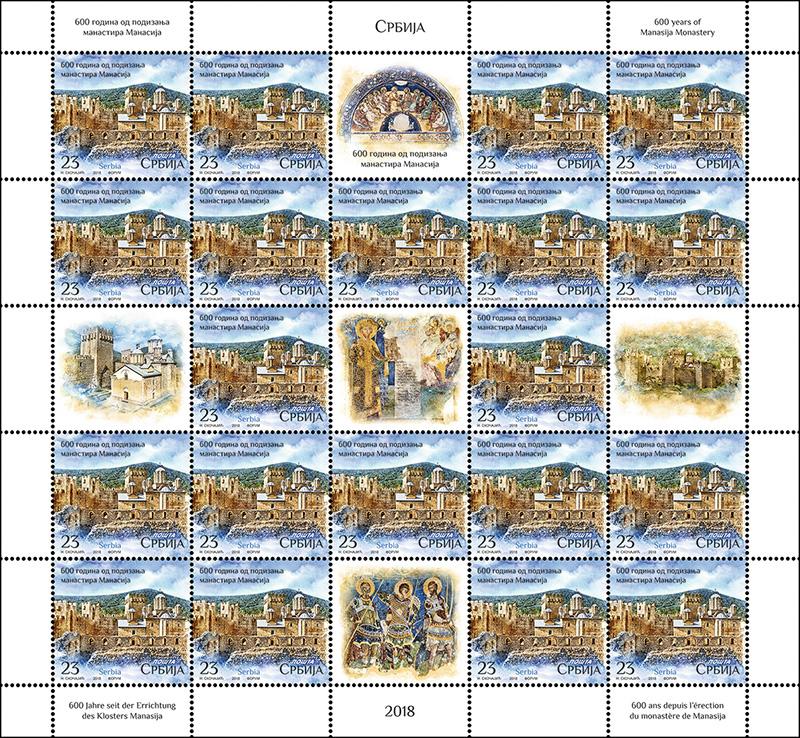


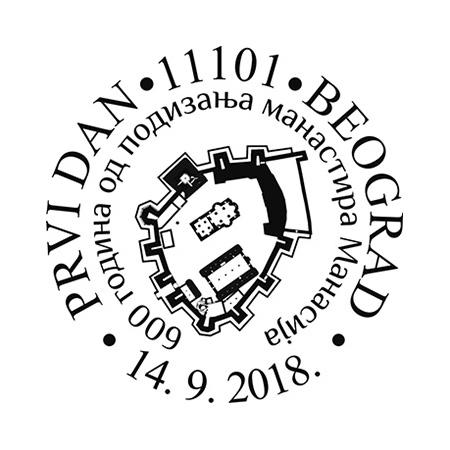
The Resava Monastery, today known as Manasija, is the endowment of the Despot Stefan Lazarević, the Serbian ruler, the son of Duke Lazar and Duchess Milica, the knight of the Order of the Dragon, the enlightener and the patron of arts and culture.
Manasija is considered to be one of the greatest achievements of Serbian architecture of the late Middle Ages, whose uniqueness lies in its fortification, designed according to all the rules of medieval fortification, which was built with the aim of protecting the monas¬tery settlement. According to Constantine the Philosopher, the construction of the monas¬tery began in 1407 and was completed in 1418. By building a monastery with the Church of the Holy Trinity, Despot wanted to build himself a mausoleum during his own lifetime.
The Church of the Holy Trinity, the central object of the monastery, belongs to a group of Moravian monuments of a developed type, and the direct model for this structure was the mausoleum of Duke Lazar. Thus in Resava, the developed cross plan combined with trikonhos, previously already implemented in Ravanica and Ljubostinja monasteries, was adopted. The diverse elements and architectural experiences, primarily present during the time of Despot, but also noticeable in endowments of the Nemanjić lineage, are remarkably combined in the Church of the Holy Trinity, making one harmonious whole. Naos is of a rectangular base, ending – on the eastern side, with a three-part altar space with semi-circular apses on the inside. On the outside, the central apse is five-sided, while the wings are three-sided. The monastery’s church narthex is square based, and its width corresponds to the width of the naos.
The upper arch structure was made, as in the naos, in the form of a developed cross. Inside the narthex, the stone floor, made of white marble, green serpentine breccia and red limestone, was partially preserved.Manasija’s iconography is, by its beauty, one of the most important achievements in medieval Serbian painting. The best painters of that time painted the frescoes of extraor¬dinary beauty, aristocratic elegance, with luxurious colouring and vivid spiritual message.
Stamp Motif: The Monastery Church of the Holy Trinity with the remains of the dining room and towers in the background. Vignette Motifs: Central Vignette in the sheet – Patron fresco on the western wall of the naos; Lower Vignette – Fresco Holy Warriors, Aretos, Nestor, and Nikita, north choir space; Upper Vignette – Fresco Descent of the Holy Spirit upon the Apostles, naos entrance; Vignettes on the left and on the right in the sheet – Manasija Monastery.
Expert collaboration: Serbian Orthodox Church, Eparchy of Braničevo.
Artistic realization: Nadežda Skočajić, Academic Graphic Artist
Serbia – India Joint Issue: 70 Years of Diplomatic Relations





The seventy-year journey of diplomatic relations based on friendship and partnership, characterized by full mutual trust and understanding between Serbia and India, began on 8 December 1948, only a year after the Republic of India became independent, crowning the struggle of Indian people and the teachings of the great Mahatma Gandhi that final victory can be won through non-violent activism, peacefully and without bloodshed.
Following the establishment of diplomatic relations, the Non-Aligned Movement was the forum where the then SFRY and the Republic of India cooperated and worked very closely, becoming important factors of international peace and stability. The words spoken by the Indian Prime Minister Jawaharlal Nehru on the occasion of the visit to Belgrade in 1955. will be remembered: “Distance dividing us vanishes in the meeting of our thoughts and the foundations have been laid for a friendship that will, I believe, be of an enduring nature”.
In the decades that ensued, a series of meetings were held, visits and letters exchanged between the top leaders, contributing to the strengthening of bilateral cooperation and position of the two countries on international level. The visit to India by the then Prime Minister and the incumbent President of the Republic of Serbia Aleksandar Vučić to participate at the “Vibrant Gujarat Summit” in January 2017, the official visit by First Deputy Prime Minister and Minister of Foreign Affairs Ivica Dačić in May 2018 as well as the visit by Vice-President of the Republic of India Venkaiah Naidu to Serbia in September 2018, are an expression of unequivocal commitment of the two countries to continue along the lines of intensified bilateral dialogue and strengthening of the overall cooperation. The Republic of Serbia and the Republic of India extended a hand of friendship and solidarity to each other in the most difficult times, while the respect of international law and principles of the territorial integrity and sovereignty of states constitute a common ground of the foreign policy of both countries.
Motifs on the stamps: Nikola Tesla, Swami Vivekananda.
Expert collaboration: Ministry of Foreign Affairs of the Republic of Serbia.
Artistic realization of the stamps: stamp “Nikola Tesla” – MA Boban Savić, academic painter; stamp “Swami Vivekananda” – Indian artist Ms. Gulistaan.
Joy of Europe




“The Joy of Europe” is the largest and oldest international manifestation of children’s creativity, founded in 1969 on the occasion of World Children’s Day. Every year, at the beginning of October, children from many countries of Europe come to Belgrade – to play, sing, act, exhibit their artwork, but above all, to make friends and have a good time. There is almost no European country whose children, during these 49 years of the event, were not guests of Belgrade.
Part of the manifestation “The Joy of Europe” since 1998 is the International Art Contest “The Joy of Europe”, which is of a competitive character. Over time, the competition has grown beyond the borders of Europe, bringing together children and young people from all over the world, and the Children’s Cultural Center Belgrade has thus gained a rich fundus of fine arts that carry irreplacible artistic values from various cultural environments. The power of children’s artistic expression is commonly known and hides within itself the great beauty of the immediate truth, which is of utmost important necessity for modern civilization. There are more and more art studios around the world that work solely with children. There are more and more pedagogues and educators who are trying not to cannonade the children’s senses and mind, but to create a space for children’s inner life, where they will imagine, create, devise in the absence of mental noise. Artistic creativity in children is an aesthetic event in which the emotional-cognitive component is embedded, wrapped in a tangled knot of numerous emotions.
From year to year, the award winning art works testify to the authenticity of the visual culture of childhood, developing the sensibility of the audience, as well as the professional public for this form of visual expression. At the prize competition, works of children between the ages of four and eighteen in five age categories are rewarded. The best children’s works find their place on the commemorative postage stamp “The Joy of Europe”.
Motif on the stamp: drawing by Teodora Despotović (7 years, Serbia). Motifs on the vignettes: drawings by Svetla Strnad Ornik (8 years, Slovenia), Heer Chauhan (9 years, India), Quentin Peng (6 years, China), Aleksandra Radujko (14 years, Serbia), Nataša Vlahović (4 years, Serbia), Teodora Tuibin (8 years, Serbia), Daniela Bila (8 years, Slovakia). Motif on the envelope: drawings by Petr Ageev (5 years, Russia), Đurđa Vasić (5 years, Serbia).
Expert collaboration: Lidija Seničar, Editor of drawing and painting competition, Children’s cultural centre Belgrade.
Graphic realization of the stamp: Jakša Vlahović, academic graphic artist.
Stamp Day




Social Philately Class is a collecting concept that has existed until recently in various exhibition classes, but it was not recognized as a class for itself. Generally speaking, ephemeris in the collections of Postal history, Aerophilately and Thematic philately contains components of social aspects. Various official documents, postcards, ship and airline companies tickets, postal traffic derivatives and the like not only are suitable for collecting, but often also improved the chosen theme. The framework for including the mentioned material in the philatelic collection is the idea of linking socio-economic history with the historical content of Philately. The goal of Social Philately Class is to present a historical narrative and illustrate the relevance and impact of the postal system in society.
Radiogram is a formalized written message transmitted via radio. It is also known as radio telegram or radio-telegraph message. Radiograms use standard message format, form and radiotelephone and/or radio-telegraphic procedures. The radiogram is transmitted via one or more radio operators all the way to the operator (PTT) that deals with the delivery of radiography content to the destination.
In the first half of the 19th century, the transmission of long distance messages via radio brought great benefits to trade, industry, stock markets, journalism and art.
Philatelistic collections of historical, social and special studies may also contain radiograms – messages transmitted by radio, printed on special radio-telegraphic blankets.
Expert collaboration: Vojislav Begović.
Artistic realization of the stamp: MA Marija Vlahović, academic graphic artist.
Christmas
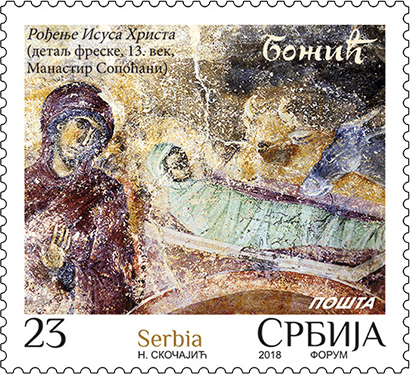





Christmas is one of the most important and one of the most joyous Christian holidays, that is celebrated both by the Orthodox and Catholic believers. The difference is only in the date of the celebration; the Orthodox celebrate it on January 7th, and the Catholic on December 25th, but its message remains the same – the message of peace and love.
We celebrate Christmas for three days. It is primarily family holiday, and there are numerous traditions and customs regarding Christmas. On the day before Christmas and Christmas Eve, the yule log is being brought into house, cresset lit and hay with hidden candies, prunes, walnuts, sugar and coins, spread all over the house. The hay is a symbol of the manger in which Christ was born. The yule log represents longevity and substance of Christianity, as well as of the warmth of the love Christ brought to us when he was born and arrived to the Earth. On the very day of the Christmas, early in the morning the church bells of all Orthodox temples are ringing, announcing the nativity of Christ. People go to church to attend Christmas liturgy and they all greet each other by “Christ has been born” and “Indeed he has”.
Stamps and envelop show the scene of the Nativity of Jesus Christ, fresco from the Sopoćani monastery from the 13th century. As one of the most beautiful frescoes of that time, it represents artistic, and above all coloristic highlight in our cultural history.
The stamp with face value of 23 dinars: detail of the birth of Jesus Christ from the scene of the Nativity of Jesus Christ, Sopoćani monastery, 13th century.
The stamp with face value of 100 dinars and envelope: detail of the bathing of Jesus Christ from the scene of the Nativity of Jesus Christ, Sopoćani monastery, 13th century.
Expert collaboration: Verica Stanković, art historian, conservator, Republic Institute for the Protection of Cultural Monuments – Belgrade.
Graphic realization of the stamps: MA Nadežda Skočajić, academic graphic artist.
Jewish Sacral Architecture in Serbia





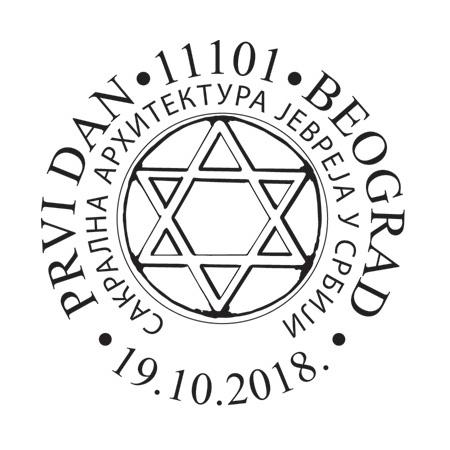
The term synagogue is of Greek origin and it indicates a Jewish municipality, i.e. the place of gathering of the Jewish community members. In Hebrew, the term which indicates a synagogue is beit knesset, and the term bet ha tefillah (the house of prayer) is also used. For the construction of synagogue as a religious object, there are no special constructional, architectural or aesthetic requirements and rules – it can be any house owned by local Jewish community.
The foundation stone of the synagogue of the Ashkenazi rite in Belgrade, Sukkat Shalom, designed by architect Milan Šlang, at 19 Maršala Birjuzova Street, was laid by king Alexander Karađorđević, and the building was built in 1925. It was consecrated after the liberation in 1944 and it has been used regularly as a synagogue to this day.
The synagogue of the Ashkenazi rite in Novi Sad, at 11 Jevrejska Street, was built in 1906 as the fifth synagogue in Novi Sad, at the same location as the previous four. It is the work of the Budapest architect Lipót Baumhorn. It was consecrated upon the liberation and it was used until 1975, and in 1991 after the restoration, it became the representative concert hall.
Subotica Synagogue was built in 1902 according to the project of Budapest architects Marcell Komor and Dezso Jakab. A harmonious monumental building of Secession style, enriched with constructive innovations – the central dome, 40m tall, rests on a steel construction of eight steel pillars. Three entrance portals lead to the narthex, above which is the space for women, and four stairs lead to the gallery. There are 850 seats on the ground floor and 550 in the gallery.
Subotica Synagogue was declared a Monument of Culture of Exceptional Importance in 1991. Conservation and restauration activities were carried out from 1980 – 1993. Since 2003, the extensive works at the synagogue completely restored the external appearance from 1902, and the works were entirely completed in 2018.
Subotica Synagogue, which is now governed by the City of Subotica, the Jewish Community and the National Council of the Hungarian Ethnic Minority, is visited by 10,000 tourists a year.
Expert collaboration: Vojislava Radovanović, Museum counsellor and director, the Jewish Historical Museum in Belgrade.
Artistic realization of the stamps: Miroslav Nikolić.
Liberation of Serbia in the Great War by the joint French – Serbian Army


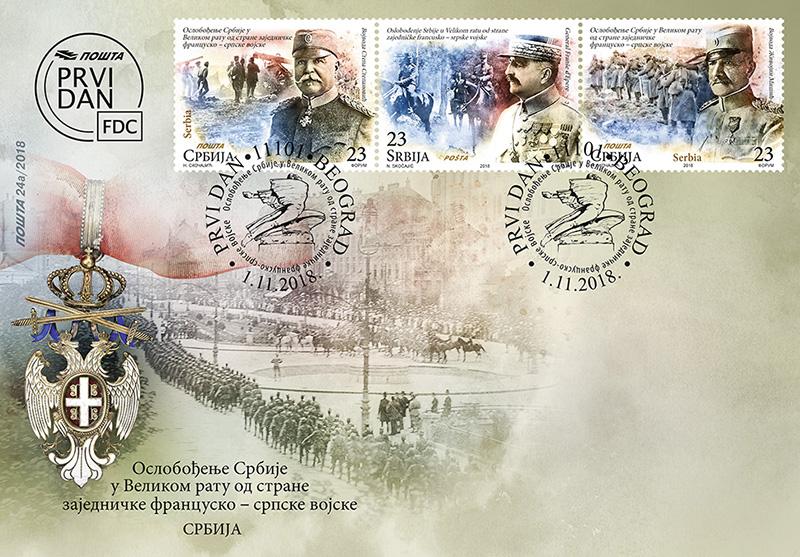


The centenary of the end of the First World War and the liberation of Serbia by the joint French and Serbian army are marked in 2018. The liberation march of the Serbian and French army, after the heroic breakthrough of the Salonika front on 15 September 2018, was brought to an end by the liberation of Serbia and the capitulation of the Bulgarian, i.e. Austro-Hungarian army, and today it is considered to be one of the fundamental elements which represents the basis of the traditional friendship between Serbia and France.
Namely, from 15 September to 1 November 1918, the Serbian and French army broke through the Salonika front and forced the Bulgarian and Austro-Hungarian army to capitulate. In their victorious march, the joint forces of the Serbs and the French took over Štip on 25 September, Veles on 26 September, Skopje on 29 September, liberated Vranje on 5 October, Leskovac on 7 October, Niš on 12 October, Jagodina on 25 October, Kragujevac on 26 October, Požarevac on 29 October, Smederevo on 30 October, and finally Belgrade on 1 November 2018.
This military operation of the joint armies of France and Serbia was also very significant for the break of the Central Forces at the western front. Bulgaria signed the truce on 29 September while the Austro-Hungarian did the same on 3 November, and the capitulation of the German Empire on 11 November marked the end of the First World War.
In the liberation of Serbia in 1918, the French army was commanded by the generals Franchet d’Esperey, Prosper Henrys and Juino-Gambetta and the Serbian generals were Mišić, Stepanović and Vasić.
Motifs on the stamps: 1. Voivoda Stepa Stepanović, in the background: At the Salonika front, before the liberation of Bitola, in autumn 1916; 2. General Franchet d’Espèrey, in the background: Prince Regent Alexander Karađorđević with General Franchet d’Espèrey, Voivoda Živojin Mišić and General Petar Bojović at Jelak, the Salonika front, 1918; 3. Voivoda Živojin Mišić, in the background: Danube division marching after Grunište, 1917 (Dragomir Glišić, photographer). 4. Entrance of the French General Auguste Charles Tranier into the liberated Prokuplje, October 1918 (Dragomir Pavlović, photographer); 5. Voivoda Petar Bojović, in the background: Prince Regent Alexander Karađorđević with General Petar Bojović and the Serbian Officers on Patron Saint Day at the Salonika front; 6. General Paul Prosper Henrys, in the background: Voivoda Živojin Mišić awarding the Order of the White Eagle to the French General Prosper Henrys, 1918.
Expert collaboration: Lieutenant Colonel Dalibor Denda, PhD, scientific cooperator, Institute for Strategic Research, University of Defense; Administration for Tradition, Standard and Veterans of the Ministry of Defense of the Republic of Serbia; Military Museum in Belgrade. Artistic realization: Nadežda Skočajić, academic graphic artist.
100 Years Since the End of the Great War – Great Doctors оf the Great War


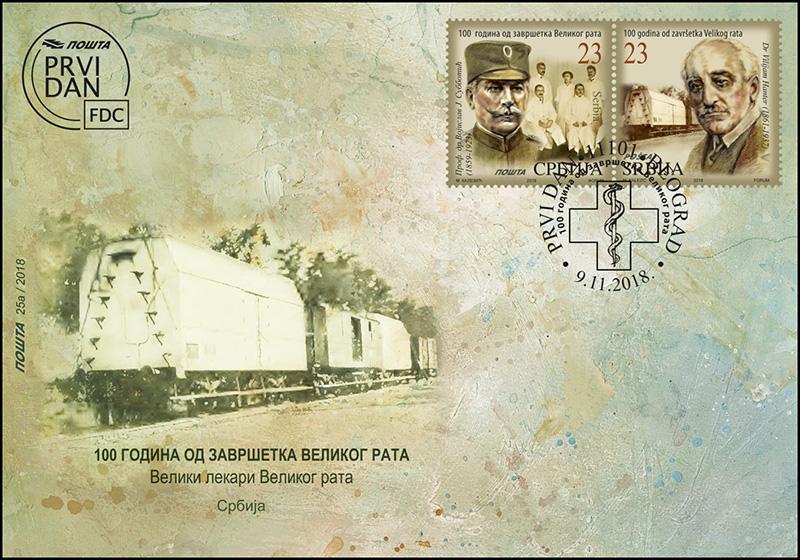


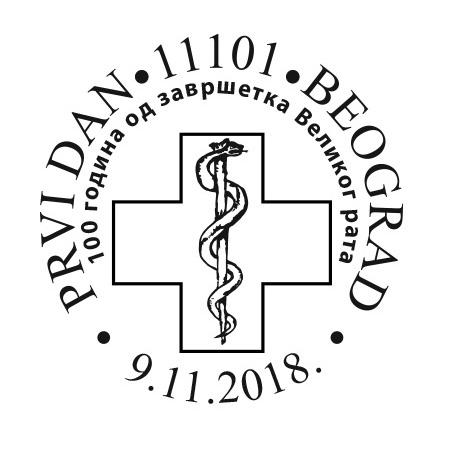
Immense contribution in treating of patients and civilians, development of medical science and practice during the First World War, along with 409 doctors and 203 medical workers of the Serbian ambulance team, gave the foreign medical missions – the English, the French and the Russian one. The Red Cross teams of doctors, as well as individuals – the volunteers, were helping their Serbian colleagues.
The greatest merit for the control of epidemics of three types of typhus, which cut down 58% of the Serbian doctors and medical staff (paramedics, nurses volunteers) had the English mission led by Dr. William Hunter. Without the help of the foreign doctors, the typhus epidemics would have hardly been controlled, and the number of the deceased (about 135,000) would have been greater by far
The names of the Serbian and the foreign doctors who gave their contribution to the work of the Serbian military ambulance during the First World War are still mentioned with the greatest respect.
Professor Dr. Vojislav Ј. Subbotić - (1859–1923)
A founder and dean of the Faculty of Medicine in Belgrade, chief of the surgical department ODB in Belgrade, father of the Serbian surgery. He studied medicine in Vienna and Paris. During the First Serbian – Turkish War in 1876, he was a volunteer in the battles on the Drina river. In the Serbian – Bulgarian War as well as in the Balkan Wars, he was a military surgeon in Belgrade. In the First World War he operated the wounded in Belgrade and Niš. After the retreat through Albania, he went to Paris and London where he was a Serbian delegate in the allied commission. At the beginning of 1918 he left for the Salonika front and worked at the First Field Surgical Hospital in Dragomanci.
He constructed femoral brace in 1916, and his method of reparation of blood vessels injuries was used until the end of the Korean War (1954). He recieved the most important awards, medals and recognitions. He was the president of the Serbian Medical Society.
Dr. William Hunter - (1861–1937)
A commander of the English military mission in Serbia during the three typhus epidemics in 1915, he suggested measures which prevented the spreading of the epidemics. As of 16 March all suggested measures were undertaken throughout Serbia, both in military and among citizens. On 25 March, a movable railway disinfector was set in Kragujevac, and on 6 April the same was done in Niš; in the meantime, on 2 April, the first English ambulance train for vaccinations was formed.
With the railway traffic interruption and abolition of military leaves, depediculation was initiated with the help of the Serbian barrel. The result of all those activities was a radical turnover in the battle against typhus and pediculosis, so that the epidemic was supressed as early as 17 May. The work of Hunter’s mission showed what the effect of the preventive measures was when they were applied on the entire endangered territory.
Dr. Miloš Đ. Popović - (1876–1954)
He graduated from the Faculty of Medicine in Vienna in 1901. In 1904 he founded the first military dentist station at the General Military Hospital in Belgrade, and the other one in 1909 at Moravska Permanent Military Hospital in Niš. He is the author of the first books on dentistry in Serbian language.
He founded the Sobriety Society in 1901, the Union of the Sober Youth in 1907, the Union of Scouts and Women Mountaineers in 1911 and the Society of Doctors and Abstainers in 1911, as well. In Voden, at the Salonika front, on 1 January 1917 at the Reconvalescent Ward he founded a dentist station which evolved into a dentist clinic. After the war, in 1919, he established the State Ward for Children’s Protection at the Ministry of Social Policy.
Dr. Edward Ryan - (1883–1923)
Dr. Edward Ryan, chief of the American Red Cross mission in Serbia, arrived in Belgrade in September 1914. In March 1915, Dr. Ryan organized a mission to fight against the typhus epidemic in Belgrade. During this epidemic Dr. Ryan came down with a difficult form of typhus fever. Dr. Ryan and his staff performed over 8,000 surgeries and coordinated the Red Cross help programme for thousands of Serbian refugees, scattered across the entire country. He died on 18 September 1923, having succumbed to malignant malaria.
For the merits rendered to the Serbian people during the Great War he was decorated with the French medal of the Knight of the Legion of Honour and the Serbian medal of the White Eagle.
Professor Dr. Mihailo Mika Petrović - (1863–1934)
A founder of the surgical ward of the Military Hospital in Niš and a surgeon consultant at the First Field Hospital in Dragomanci at the Salonika front, where he stood out as a restless war surgeon. In the Balkan Wars and the First World War, Petrović became an outstanding surgeon. He introduced many innovations into the war surgical doctrine, and one of them is the treatment of war wounds by all the principles of asepsis and antisepsis. He was a professor of surgery at the Faculty of Medicine in Belgrade and the president of the Serbian Medical Society.
After his death, his heart was built in the wall of the surgical hall of the Main Military Hospital in Belgrade. On his urn the following was written: My soul to God, my body to earth, and my heart to surgery. He is a holder of 17 decorations and medals, among which is the Medal of the French War Cross with a Palm.
Professor Dr. Ludwik Hirszfeld - (1884–1954)
Dr. Ludwik Hirszfeld came to Serbia in February 1915 and at his own request he was sent to Valjevo where he organized systematic disinfection and depediculation of the entire town, thanks to which the typhus epidemic began to wane. After the retreat through Albania, he worked at the Salonika front as a leading bacteriologist of the Serbian army. He isolated the causitive agent of paratyphus C, now called Salmonella hirszfeldi. With a pentavalent vaccine, which he produced in 1917, the first to be vaccinated was voivoda Mišić, then members of the headquarters, officers and over 110,000 of combatants.
At the Serbian hospital of Prince Regent Alexander, in 1918, he organized the first bacteriological course for the ambulance officers and medical staff. After the breakthrough of the Salonika front, Dr. Ludwik Hirszfeld was appointed as a chief of the bacteriological ward of the Military Hospital in Belgrade. He was decorated with the Order of Saint Sava, third class and the Order of the white Eagle with swords.
Artistic realization of the stamps: MA Marina Kalezić, academic painter.
Expert collaboration: Dr. Zoran Vacić, Serbian Medical Society.
100th Anniversary of the accesson of Vojvodina to the Kingdom od Serbia



During the battles of liberation of Serbia in the First World War, after the break-through of the Salonika front on 15 September 1918, the army of the Kingdom of Serbia crossed the rivers Drina, Sava and Danube while advancing in October 2018, and liberated Srem, Banat, Bačka and Baranja.
As of 3 November 1918 the Serbian National Board operated publically in Novi Sad, led by Jaša Tomić, who had the role of a centralized temporary Government body for Vojvodina region, due to the fact that the Government bodies of Austro-Hungary ceased to functi-on, and Hungary had seceded from Austria on 30 October 1918 causing that state to cease to exist.
The Serbian National Board summoned The Great National Assembly of the Serbs, Bunjevci and other Slovenes from Banat, Bačka and Baranja on 17 November. One envoy per one thousand inhabitants was chosen, and the right to vote had people older than 18 years of age, both men and women. The Assembly was multi-national and multi-party, and it was held on 25 November in Novi Sad. There were seven women among 757 envoys. The envoys of the assembly represented 211 municipalities from Banat, Bačka and Baranja, and the assembly was attended by the members of the Board from Novi Sad, Serbian and French officers who were in Novi Sad at the time, as well as the representatives of Srem, who passed similar resolutions for Srem on the previous day, at the Great National Assembly in Ruma.
The Great National Assembly passed the following resolutions: 1. Resolution on se-cession of Banat, Bačka and Baranja from Hungary; 2. Resolution on accession of these terri-tories to the Kingdom of Serbia. Additional resolutions deal with protection of the rights of the non-Slavic minorities, protection of the rights of the Serbs, Bunjevci and other Slovenes who stayed in Hungary, and the election of Great National Assembly which would set up the National Administration for Banat, Bačka and Baranja.
A special delegation of the Assembly delivered the resolutions to the Government in Belgrade and prince regent Alexander. With the December 1 Act from 1918, the Kingdom of Serbs, Croats and Slovenes was created, which means that Vojvodina region entered the new state as a part of the Kingdom of Serbia.
Motif on the block: Great National Assembly in Novi Sad, 25 November 1918, Anastas Bocarić, oil on canvas, 1927 (ownership of the City Museum in Subotica, in the permanent exhibition of the Museum of Vojvodina).
Motif on the FDC: Traditional Coat of Arms of Vojvodina and Coat of Arms of Kingdom of Serbia.
Expert collaboration: Drago Njegovan, PhD, Director of the Museum of Vojvodina.
Graphic realization of the block: Nadežda Skočajić, academic graphic artist.
150th Anniversary of the Construction of the Church of the Holy Emperor Constantine and Empress Helen in Crvena Jabuka near Vlasotince




Crvena Jabuka is a mountain village located in the valley of the upper course of the Tetošnica river, huddled between the Tumba, Talambas and Crni Vrh mountains, near the border with Bulgaria in the southeastern part of the Babušnica municipality.
As tradition has it, the settlement was built in the 12th century on the remains of a Latin settlement and it is one of the oldest in the Lužnica region. Until the liberation from the Turks in 1877, the village belonged to the Trn county, afterwards to the Vlasotince county and as of 1900 to the Lužnica county in the Babušnica municipality.
Until 1868 the village did not have a church because the Turks had burned down the church at the village cemetery twenty years before. At that time Crvena Jabuka was economically developed and densely populated, so on 3 October 1867 sultan Abdulaziz allowed for the church to be build, which was done in less than a year in the village centre, near the village school. During the digging of the foundation, a construction which was found was considered to originate from the period of the emperor Constantine, so the church was named after him and empress Helen. It was finished and consecrated on 3 June 1868, since when St Constantine’s Day is celebrated.
The Holy Gospel, which is now kept in the National museum of Babušnica, was donated to the church by a priest from Strelac, Milan Rakić and a merchant from Crvena Jabuka David Petković, the envoy in the Assembly in 1878. While visiting the newly liberated parts of the country on 12 October 1892, king Alexander Obrenović donated a large bell to the church and a small one to the school in Crvena Jabuka.
The church iconostasis was carved in wood, and there is a cross in the front with the year of the construction engraved. Near the church there is a memorial named ’’A Flame in the Stone’’, built in 1989 in the memory of all the residents of Crvena Jabuka that had fallen in the liberation wars from 1877 to 1941.
The first birth registration in the church books, which are kept until today, was done in 1879, so these books represent a significant source of information about the families of Crvena Jabuka of that time. The church was renovated in 2011, and the 1700th anniversary of the Edict of Milan was solemnly celebrated there on 3 June 2013.
Expert collaboration: Homeland citizens’ Association ’’Crvena Jabuka”, Odžaci.
Artistic realization of the stamp: Miroslav Nikolić.
International Day of Persons with Disabilities




Celebrating 3rd December – International Day of Persons with Disabilities was proclaimed in 1992, by the United Nations General Assembly Resolution which invited all countries to celebrate this day with an aim to improve and enable persons with disabilities to exercise equal human rights and equal participation in society.
Bearing in mind the permanent commitment of the Republic of Serbia to enable full equality for all its citizens, Government of the Republic of Serbia and Ministry of Labour, Employment, Veteran and Social Policy dedicate special attention to the improvement of the situation of persons with disabilities and are making great efforts to develop cooperation with Associations of persons with disabilities representing the interests of all categories of persons with disabilities in the Republic of Serbia.
This year the International Day of Persons with Disabilities is celebrated with a graphic slogan Ј=ДНАКИ (meaning equal).
Expert collaboration: Government of the Republic of Serbia, Ministry of Labour, Employment, Veteran and Social Policy.
Artistic realization: MA Jakša Vlahović, academic graphic artist.
Slava – Celebration of Family Saint Patron’s Day
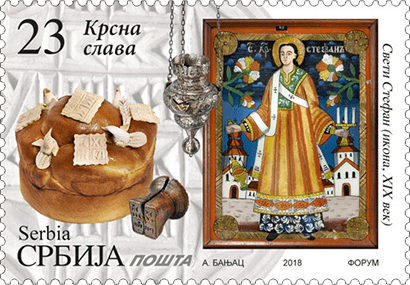






Slava, celebration of family saint patron’s day, represents a ritual dedicated to a certain Christian saint who is believed to be a family’s patron saint and the giver of welfare. Celebrating a patron saint is practiced by a majority of Orthodox Christian families on the territory of Serbia as a significant family holiday with the participation of individual families and their guests – members of wider kinship, neighbours, friends. The Serbs experience patron saint’s day as a way of expressing national identity and they are the bearers of this tradition, but the celebration of a family patron saint are also practiced by Orthodox Christian families of some other ethnic communities in Serbia.
In the home of a family, on patron saint’s day a candle is lit during the performing of the ritual, The Lord’s Prayer is said and a ritual cutting of the Slava cake is performed – which necessarily has an impressed symbol IС ХС НI KA – in a way that it is overflowed with wine, cut in the shape of the cross, then it is turned, lifted up and broken in four parts. During the ritual the words of gratitude and prayers for welfare are said to the patron saint. Ritual cutting of the cake is performed by all the members of the family at their home, but on the other hand, it is a common practice to take the Slava cake to church, and in some cases a family welcomes their priest at home to cut the cake. An important part of the celebration of a patron saint is a feast which gathers together the whole family and their cousins and friends.
Patron saint’s day is a vital element of our intangible cultural heritage and in 2014 it was entered on UNESCO Representative list of Intangible cultural heritage of the humankind.
St. Stephen, 9 January – It is celebrated as the third day of Christmas, and some families celebrate it as their family patron saint day. The custom is that on that day the Christmas straw is taken out of a home.
Motif on stamp: St. Stephen, (icon, late 19th or early 20th century, Sombor), Slava cake, cresset and letter–mold for Slava cake.
Motif on FDC: St. Stephen, (icon, 19th century, Debeljača).
Photographs of exhibits of Ethnographic Museum in Belgrade, by author Ivana Masniković Antić MA, were used for motifs of stamps and envelopes.
Expert collaboration: Ethnographic Museum in Belgrade.
Icon and engravings are located in the collection of the Matica Srpska Gallery in Novi Sad.
The album of remembrance to our ancestors from the First World War




The project “The Album of Remembrance to Our Ancestors from the First World War” was initiated by the Association of Descendants of the Warriors from Serbia in 1912–1920, and has resulted in a desire to pay homage to an individual, today, a hundred years later, to a Serbian soldier, that little man involved in the Great War for civilization, his unselfish sacrifice for justice, freedom and truth – and represents a part of collected historiographic material from the period of First World War, that the descendants had sent in honor of their ancestors, the participants of the Great War.
Having realized that an ordinary, anonymous warrior–peasant was the one who formed the Serbian history equally with the military leaders, the kings and the statesmen, the public call was launched for the citizens of Serbia and the Serbs in the region and the diaspora to deliver the photographs and other documents from the First World War and participate in creating “The Album of Remembrance to Our Ancestors from the First World War”.
There are over 4000 units in the gallery of the Commemorative Album, first-class testimonies – photographs, war diaries, military letters, correspondence cards, memorials and other historiographic material of the First World War participants. These are unique testimonies of the war adventures and sufferings of the Serbian soldier in the war years, depressed from the pages of world history.
The history invites us to show “memory skills” and take on personal responsibility for the future of our descendants. The history obliges us to tell a great story about our famous ancestors and to make their great sacrifice into a cultural heritage rather than erase it from our civilization’s memory.
Expert collaboration: Roksanda Aleksić, Dušan Mladenović, Aleksandar Vasilić, Association of Descendants of the Warriors from Serbia in 1912–1920.
Graphic realization of the stamps: MA Jakša Vlahović, academic graphic artist.